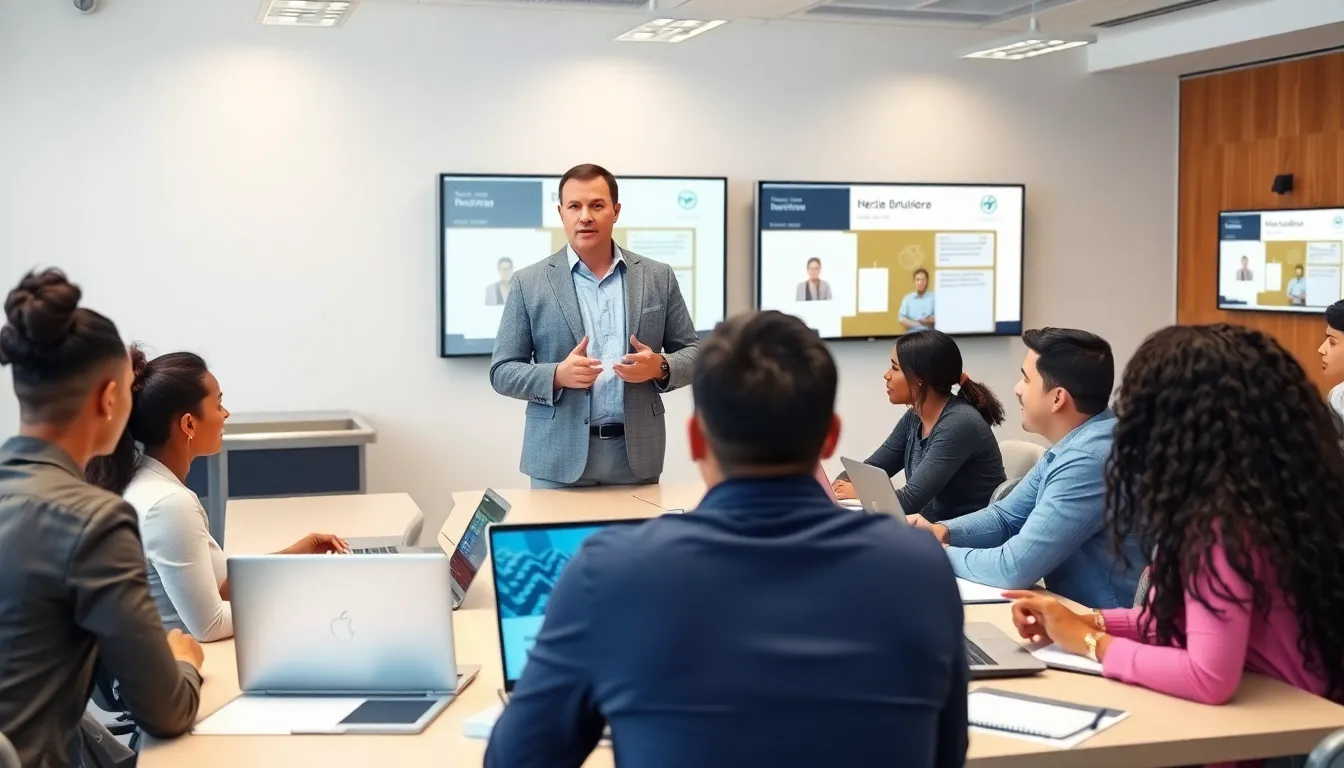Table of Contents
ToggleIn a world where knowledge is power, training materials are the secret sauce that turns potential into performance. Imagine trying to bake a cake without a recipe—chaos, confusion, and maybe a few eggs on the ceiling. That’s what it’s like to train without the right materials. Effective training resources not only guide learners but also keep them engaged and motivated to master new skills.
Overview of Training Materials
Training materials serve as essential tools in developing skills and enhancing performance. Various formats exist, including manuals, presentations, videos, and online courses. Organizations utilize these diverse materials to address the unique learning styles of individuals.
Effective training resources engage learners actively. They offer clear instructions, practical examples, and interactive elements that promote knowledge retention. In addition, incorporating assessments enables participants to evaluate their understanding and progress.
Designing impactful training materials requires attention to detail. Customization based on target audience enhances relevance and motivation. Leveraging technology enhances accessibility. For instance, digital formats allow for on-demand training at one’s convenience, leading to more effective learning experiences.
Collaboration among subject matter experts, designers, and trainers is vital. This teamwork ensures content accuracy and alignment with organizational goals. Regular updates keep materials current and reflective of industry standards.
Ultimately, the goal of training materials focuses on fostering an engaging and supportive learning environment. They facilitate the seamless acquisition of new skills and knowledge, making the learning process efficient and rewarding.
Types of Training Materials


Training materials come in various formats, each designed to enhance the learning experience. Understanding these types helps organizations provide effective and relevant resources.
Instructor-Led Materials
Instructor-led materials focus on classroom and live training environments. They often include lecture notes, training guides, and participant handouts. These resources support trainers in delivering content interactively. Engagement occurs through discussions, demonstrations, and hands-on activities. Additionally, feedback opportunities allow participants to clarify their understanding. This format suits learners who benefit from real-time interaction and expert guidance.
Self-Paced Materials
Self-paced materials enable learners to absorb information at their own speed. Training manuals, workbooks, and online tutorials fall into this category. Individuals can revisit content as needed, facilitating better retention. This structure allows for flexibility, accommodating various schedules and lifestyles. These materials often include exercises and quizzes, reinforcing concepts while measuring progress. Self-paced options cater to independent learners who prefer a tailored approach to training.
Digital and E-Learning Resources
Digital and e-learning resources encompass a wide range of online content. Videos, interactive modules, and webinars represent popular formats. These materials often provide multimedia experiences that cater to diverse learning preferences. Accessibility enhances their appeal, enabling learners to study anytime and anywhere. Tracking and analytics help organizations monitor engagement and progress. E-learning resources support a modern approach to training, fostering continuous development at scale.
Importance of Effective Training Materials
Effective training materials play a crucial role in ensuring successful learning experiences. These resources not only facilitate knowledge transfer but also foster an engaging atmosphere that motivates learners.
Enhancing Learner Engagement
Interactive elements capture learners’ attention, making training sessions more dynamic. By incorporating multimedia formats like videos and quizzes, trainers can cater to diverse learning preferences. Practical examples demonstrate real-world applications, enabling learners to connect theory with practice. Personalized content can strengthen understanding, as it aligns with individual interests and needs. Collaboration among trainers and content creators leads to innovative materials that resonate better with participants. Engaged learners become active participants, boosting class participation and discussion.
Improving Knowledge Retention
Retention of information improves when training materials reinforce critical concepts. Visual aids help participants remember key points, as the brain processes images more efficiently than text alone. Regular assessments, through quizzes or follow-up activities, ensure learners can recall information effectively. Revisiting topics periodically aids long-term retention, allowing learners to reinforce what they’ve learned. Customized materials address specific knowledge gaps, leading to stronger comprehension. Overall, effective training materials transform information into long-lasting skills and knowledge.
Best Practices for Creating Training Materials
Effective training materials require a strategic approach aimed at enhancing learner engagement and knowledge retention. Adapting content to the specific needs of the audience ensures relevance and maximizes motivation.
Tailoring Content to the Audience
Tailoring content involves understanding the target audience’s background and skill level. By customizing material, trainers address varying learning styles and preferences. Engaging examples from the audience’s industry create a relatable context. Language simplicity enhances comprehension, making it accessible to all learners. Assessing prior knowledge before beginning helps identify gaps and allows for targeted reinforcement. Frequent feedback loops during training sessions inform ongoing adjustments, ensuring continuous alignment with learner needs.
Utilizing Multimedia Elements
Utilizing multimedia elements significantly enriches the learning experience. Incorporating visual aids like charts and infographics enhances understanding and retention. Videos help break down complex concepts into engaging formats. Interactive content increases participation and keeps learners focused on their objectives. Audio clips provide varied ways for learners to absorb information, accommodating different preferences. Regularly integrating these elements caters to diverse learning styles and fosters a more inclusive environment. Assessing multimedia effectiveness through learner feedback ensures the training remains engaging and relevant.






